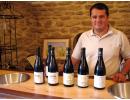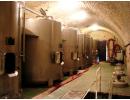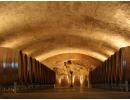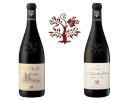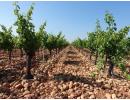Plateau des Chenes
Plâteau des Chênes 2015 - Lirac
The wine is a blend of 25% Syrah and 75% Grenache Noir. The 25 year old grapes produce an average yield of 20 hl/ha which is fairly low. The hand-picked grapes are destemmed then fermented separately in stainless steel vats for 3 weeks at 25°C and aged separately in oak barrels for 9 months. The Syrah is aged in 228 litres french oak barrels while the Grenache is aged in demi-muids of 400 litres. The wine is bottled without filtration.
PVins notes: This dark coloured wine offers a complex nose of blackberry fruits with hints of spice and a little smokiness. Full-bodied, the tannins are firm in its youth but fine grained, it is well-balanced by the freshness and the oak is very well integrated on the long finish. A Chateauneuf du Pape in style, structured to age, so a little cellaring over 1 to 2 years on release is recommended, it will age elegantly over 10+ years.
Press:
Wine Advocat 90
The 2015 Lirac Plateau des Chênes is a modern, somewhat oaky example of the appellation, but it does combine wonderfully pure cherry fruit with vanilla and cedar, leaving some woody tannins in its wake. Drink this medium to full-bodied blend of Grenache (75%) and Syrah (25%) over the next 5-8 years.
Wine Spectator 90
Offers a fleshy feel, with dark plum and raspberry coulis flavors racing along, lined with subtle graphite and black tea notes. Shows a dusting of cocoa at the very end. Solid.
Jeb Dunnuck 92
The 2015 Lirac Plateau des Chenes is the same Grenache-Syrah blend as the 2016, yet offers more Syrah character in its dark fruits, peppery herbs, and earthy/meaty aromas and flavors. Full-bodied, ripe and beautifully textured, it offers a serious mouthful of fruit and is highly recommended. It should keep for 7-8 years.
Other wines produced by the Family Bréchet are Château de Vaudieu in Châteauneuf du Pape and Domaine des Bosquets in Gigondas.
The vineyard of Plateau des Chênes is located on 3 communes: Lirac, Roquemaure and Saint-Laurent-des Arbres. This estate was a new acquisition in 2010 by the family BRECHET. The family is well known for producing Château de Vaudieu in Châteaufneuf du Pape and Domaine des Bosquets in Gigondas. The Bréchet have a long history as winegrowers in the region (see Château de Vaudieu). It is Laurent Bréchet that manages the estate with the advice of well-known oenologist consultant Philippe Cambie.
The estate’s 25 ha located on the three communes of Lirac, Roquemaure and Saint-Laurent-des Arbresare situated on a plateau. The terroir is composed of alluvial deposit from the Rhône River, red clay, Pliocene sand and pebbles. The vines have an average age of 25 years and the grape varieties planted are the Syrah (50% of the estate), Grenache Noir and Cinsault for the reds and Grenache Blanc, Clairette and Roussanne for the whites which represents a small percentage of the vineyard.
The vineyard is sustainably farmed with some organic principals. Canopy management and green harvest is practiced when necessary, the harvest is hand-picked.
The harvest is hand-picked at a high maturity early in the morning to keep the night’s freshness. The fruit is then transported to the cellar at Château de Vaudieu across the Rhône River in Châteauneuf. A first tri will be done at time of picking and a second sorting at the cellar. The average yield is 25 hl/ha. The red grapes are destemmed, depending on the wine the fermentations will be done in stainless steel vats or the new tulip shaped concrete vats for 3 to 4 weeks, each grape variety is fermented separately. The wine is then aged in 1-2 years old oak barrels for 9 to 18 months depending on the wine. The Syrah is aged in oak barrels of 228 litres while the Grenache is aged in demi-muids of 400 to 600 litres depending on the wine. The wines are estate bottled without filtration.
Laurent produces 2 reds and a white, the main red is named “Plateau des Chênes” and the premium is named “Le Temps”. The latter is nearly 100% Grenache Noir with a touch of Syrah, the Grenache grapes are from the best parcels that have a pebbly soil structure similar to Châteuneuf du Pape.
For the white Lirac the grape varieties are Grenache Blanc, Clairette and Roussanne, it is produced in a small quantity. The grapes are fermented in stainless steel vats at 18°C to 22°C. The wine is then aged in demi-muids barrels of 600 litres for 6 months.
Links: AOP Lirac - Southern Rhone map
LIRAC
Created in 1947, the Lirac appellation is located in the southern Rhône situated on the right-bank of the Rhône River about 15 kilometres north-west of Avignon and 11 kilometres south-west of Châteauneuf du Pape. The vineyards spread over four communes in the Gard region and represent 715 hectares. It is one of the rare appellations in the Rhône to produce red, white and rosé wines.
History
As far back as the middle ages the wines from this area have been known for their quality. In 1727, efforts were taken by the winemakers to protect the wine’s name by branding “C.D.R” for “Côte du Rhône” on the barrels to certify their contents. In 1925, the decision was made to replant the vineyard up to its Roman-era boundaries and the following decade saw the battle to win the AOC designation for the terroir of Lirac. It became an official Côtes du Rhône cru appellation in 1947.
Vineyard
The terroir is complex, around the village of Lirac the vineyards are planted on a limestone plateau that is covered with a layer of red clay and pebbles. Well drained, this terroir produces strong wines with solid tannins and a significant potential for ageing. In the centre of the appellation around Saint-Laurent-des-Arbres, the vineyards are planted on ancient alluvial terraces of the Rhône River, made up of quartz pebbles and red clay carried down from the Alps lying on top of a bed of sand. The formation of these terraces, are from the same geological age (quaternary era) as Châteauneuf du Pape just across the river.
The Lirac red grapes are Grenache Noir (minimum 40% in the blend), Syrah, Mourvèdre and Cinsault which thrive on the clayey plateaus with their large pebbles. The main white grape varieties in the appellation are Grenache Blanc, Clairette and Bourboulenc but a small quantity of Roussanne, Picpoul, Marsanne and Viognier are also planted. The various wines from the different terroirs are what define the Lirac style: strong, structured and aromatic, but always fresh and elegant.
The Lirac’s similarity to Chateauneuf du Pape has encouraged some producers from Chateauneuf to invest in this appellation. The red wines have a deep ruby colour and show aromas of red fruits, black fruits, scrubland and spices. As they age, they develop aromas of leather, liquorice, truffles and cocoa and they have a very good ageing potential. The white wines produce floral and fruity aromas of acacia mixed with peaches, apples and tropical fruits. Over time, the aromas evolve into honey and scrubland. They are delicate and refined on the palate with a wonderfully fresh finish.
Climate
The area benefits from a Mediterranean climate. The Lirac vineyards boast exceptional exposure to the sun with 2,700 hours per year. The heat stored by the rocks during the day and released at night enables the grapes to reach optimal ripeness. Summers are warm and dry with the occasional violent stormy period. The winters are mild with frequent precipitations but snow is rare. Another element is the Mistral, which is a strong wind from the north that blow through the Rhône Valley for nearly half the year, it keeps the grapes dry and healthy especially after a rainy period.



